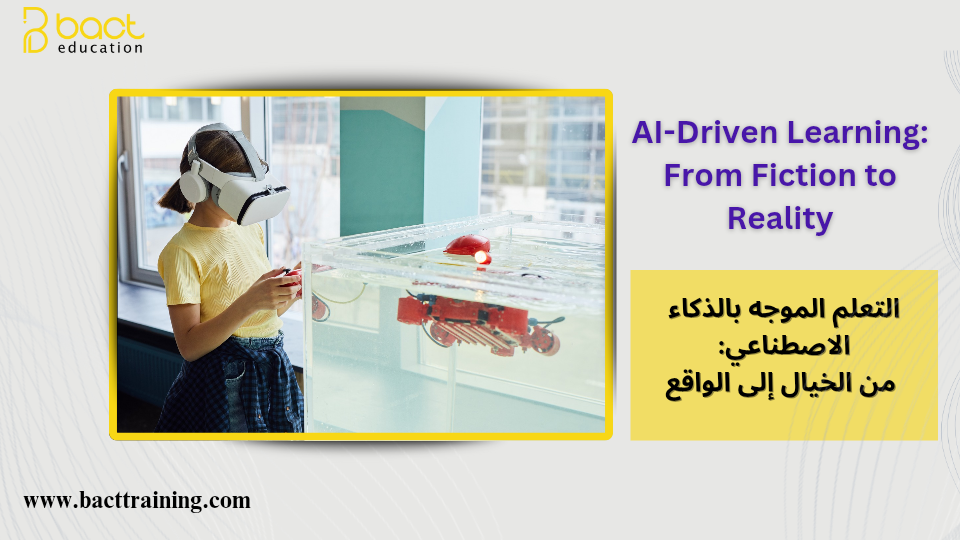AI-Driven Learning: From Fiction to Reality
Introduction:
In recent decades, technological advancements have been nothing short of remarkable, with artificial intelligence (AI) emerging as one of the most influential fields across various aspects of life, including education. For a long time, AI in education was merely a futuristic concept depicted in movies and books, featuring smart classrooms and robotic teachers capable of providing individualized instruction tailored to each student’s abilities. However, this vision has now become a reality, thanks to rapid advancements in AI technologies. Educational institutions can now leverage AI to enhance learning processes, personalize curricula, and create a more efficient and inclusive educational experience.
AI-Driven Learning: Applications and Mechanisms:
1) Adapting to Individual Learning Styles
AI-powered educational systems can analyze each student’s performance and learning behavior to understand their unique needs. Adaptive learning systems use advanced algorithms to modify content based on a student’s level of understanding. For instance, if a student struggles with a particular topic, the AI system can suggest additional materials or interactive exercises to reinforce comprehension, while advanced students receive more challenging tasks to maintain their engagement.
2) Instant Performance Analysis and Feedback
AI technologies enable teachers and students to receive real-time feedback on performance, fostering continuous learning improvement. Data analytics tools monitor student progress and compare it against predefined benchmarks, helping students identify their strengths and areas for improvement. For example, some educational platforms generate detailed reports on reading and writing skills, offering personalized recommendations for enhancement.
3) Smart Assistants and Voice Interaction
Students can now benefit from AI-powered assistants such as Siri, Google Assistant, and Alexa, which provide quick and easy answers to educational inquiries. Additionally, interactive AI systems feature educational chatbots that act as digital tutors, allowing students to ask questions and receive instant responses. This enhances student engagement and makes learning more interactive and enjoyable.
4) Translation and Language Integration Technologies
AI supports the development of real-time translation tools that help students from different linguistic backgrounds understand educational content in their native languages. These technologies promote inclusive learning environments by integrating students from diverse cultures into the same educational setting. Moreover, AI enables teachers to deliver content in multiple languages without the need for a human translator.
5) Automated Assessment and Grading Technologies
AI systems help reduce teachers’ administrative workload by offering tools for automatic test grading and result analysis. This allows educators to focus on developing creative teaching strategies rather than spending excessive time on manual grading. Additionally, AI-driven assessment ensures accurate and unbiased evaluation of student performance, promoting fairness in the grading process.
Benefits of AI-Driven Learning:
1- Enhancing Education Quality
AI plays a crucial role in improving curricula by aligning them with labor market demands. Educational content is continuously updated to include essential digital-age skills. Moreover, big data analysis helps identify gaps in curricula and suggests solutions for improvement.
2- Ensuring Equal Learning Opportunities
By making educational content accessible online, students in remote areas or developing countries can receive the same level of education as those in top-tier institutions. Additionally, adaptive assessments ensure that each student receives the necessary support tailored to their individual needs, reducing the educational gap among learners.
3- Boosting Engagement and Interaction
AI-powered technologies introduce interactive teaching methods that encourage student participation. For instance, augmented reality (AR) and virtual reality (VR) provide immersive learning experiences that simulate real-world scenarios, enhancing comprehension more effectively than traditional methods.
Challenges and Potential Risks:
-
Data Privacy and Security Concerns
With the vast amount of student performance data being collected, it is essential to establish strict policies to protect this information from breaches or unauthorized use. Educational institutions must ensure compliance with digital security standards to safeguard student data.
-
The Need for Teacher Training
Integrating AI into education requires teachers to be proficient in using these technologies effectively. Many educators struggle to adapt to AI-driven systems, highlighting the need for comprehensive training programs to maximize the benefits of AI tools.
-
Risks of Over-Reliance on Technology

